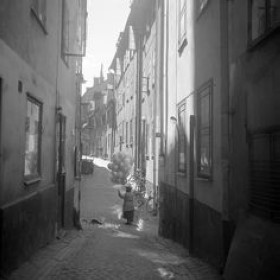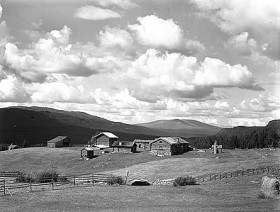


Sune Jonsson: Nine reflections /2
NINE REFLECTIONS CONCERNING 1/125th
By Sune Jonsson (1978)
2
An action, a façade, a room in someone’s home, a face – any of these is always a sum. This sum can be described, if one wishes, as heritage, environment, tradition, everything that with the consistency of natural law marks people and societies. If the camera’s 1/125th, with its particular slice of new describes that sum with knowledge and empathy, one can speak of genuine documentary photography, of personal and well informed messages that concern us because they broaden our horizon and enlarge our experience.
Lennart af Petersens is one of Sweden’s finest documentary photographers. When Kurt Bergengren describes his accomplishments, he expresses himself with characteristic pithiness, speaking of a Petersens’s “ability to photograph Stockholm from a distance of several centuries” or of documentary photography as being, I his case, an “exciting occupation for an educated man”.

Documentary photography is an art form that describes the world from the viewpoint of a personal vision that is based on profound knowledge and vigorous empathy. One can even claim that knowledge has to be the basis of all documentary-photography methodology. Since the photographic image is a fragment of reality, that fragment – if it claims to convey anything of general truth – must exhibit a representative portion of a long tradition, contain in it slice of now a large measure of analysis and summation, be irrefutably environment-specific. This demands, in addition to knowledge, that the photographer be capable of conforming to an empathy that, ideally, becomes synonymous with his identifying with the subject matter he is depicting. One magnum opus having such qualities is C. G. Rosenberg’s austerely constructed landscape syntheses, which now, one photographer generation later, stand out as monumental testimony concerning transformations of the Swedish landscape at the hands of a man. (To be continued on Filmkommentaren with seven more reflections…)

PHOTOS
Sune Jonsson: Mannen i det blå huset, 1957. Sune Jonsson skriver i billedteksten i sin bog Album – fotografier fem decennier, 2000, hvorfra billedet er hentet: ”… esperantisten Joan Engman, Djupsjönäs, Nyåker, med sin Dürerbiografi på esperanto… Ett 40-talslandskab som fortsætter at avlägsna sig, samtidigt som det bygger ett ålderdomshem inne i mig.”
Lennart af Petersens: Stockholm, Gamla Stan. Prästgatan / Kåkbrinken, 1940’erne.
C. G. Rosenberg: Svensk landskab, 1920’erne.
Publisher of the newspaper catalogue including Sune Jonsson’s essay: Finn Larsen info@finnlarsen.se Read more in Tue Steen Müllers review:
http://www.filmkommentaren.dk/blog/blogpost/3598/
Om Sune Jonsson og hans metode i Allan Berg Nielsens præsentation af hans essay:
https://randersbiografien.wordpress.com/museum-samling/ (Scroll til overskriften Feltetnolog)